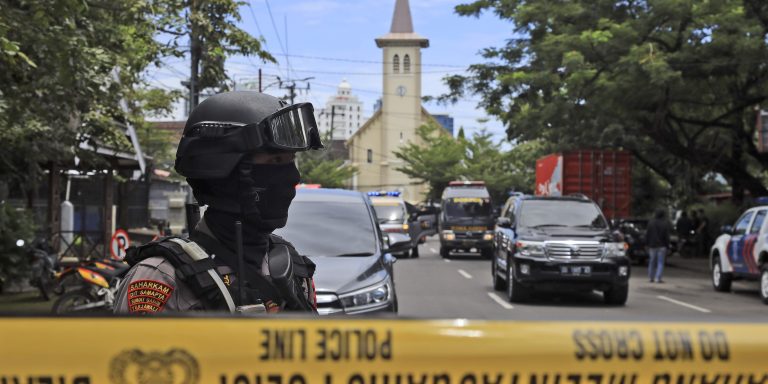INTELBRIEF
April 5, 2021
IntelBrief: Resurgence of Terrorism in Southeast Asia

Bottom Line Up Front
- A string of recent terrorist attacks and plots in Southeast Asia has authorities concerned over the enduring threat posed by regional terrorists.
- Militant groups tied to the Islamic State have repeatedly sought to attack targets associated with Christians, including churches, as well as police.
- The attacks feature an increasing number of women as perpetrators, often alongside husbands and family members – a trend which may grow.
- In online chat forums, ISIS supporters in Malaysia and Indonesia called for further attacks and suggested that militants resort to more powerful explosives.
A powerful explosion ripped through a church compound in Indonesia last week in a stark reminder of the terrorist threat still facing Southeast Asia. The attack, which occurred on a gated compound housing the Sacred Heart of Jesus Cathedral in the city of Makassar in South Sulawesi, was perpetrated by a newlywed husband and wife team riding a motorcycle. The attack targeted a church service on one of the holiest days of the Roman Catholic calendar, Palm Sunday. While at least twenty people were injured in the bombing, the only deaths were those of the attackers. Reports indicate that the bomb blast was powerful, suggesting that if the terrorists had reached their intended target, casualties would likely have been devastating.
Since the attack, Indonesian police have arrested at least twenty-three individuals believed to be part of a broader network. The arrests took place across Makassar, Greater Jakarta, and West Nusa Tengarra. Weapons and bombmaking materials were confiscated during raids on the homes of known militants, including pre-made pipe bombs and ingredients to make triacetone triperoxide (TATP), a powerful explosive often used in terrorist attacks. One woman in particular was charged with “motivating” the assailants to commit the attack. The attack has been attributed to Jammah Ansharut Daulah (JAD), a jihadist network with linkages to the Islamic State. Several days after the attack on the church in Makassar, a 25-year-old female ISIS supporter fired six shots at the Indonesia National Police Headquarters in the capital, Jakarta. The attacker, described by authorities as a “lone wolf” who left behind a letter which hinted at the extent of her radicalization, was shot dead by police.
ISIS has launched attacks over the past several years throughout Southeast Asia and has also targeted Christian houses of worship in Indonesia and the Philippines. JAD militants have also attacked police and law enforcement targets. In May 2018, three churches were attacked in Indonesia’s second largest city, Surabaya, resulting in dozens of casualties. The suicide bombers were a husband and wife and their four children. The attacks feature an increasing number of women as perpetrators, often alongside husbands and family members, a trend which may grow. Couples are perhaps believed to draw less suspicion and could potentially gain easier access to their intended targets by circumventing or being overlooked by security. On the same day that one family attacked three churches in Surabaya, later that evening another family detonated its IEDs when police raided its home. The next morning, a third family attacked the National Police headquarters in Surabaya. Terrorist attacks have also rocked the southern Philippines, as well; a Catholic cathedral in Jolo has been attacked numerous times over the last several years.
In online chat forums, ISIS supporters in Malaysia and Indonesia called for further attacks. Concerns are growing over continued violence in the coming weeks. In past years, Southeast Asia has experienced an uptick in terrorist attacks during the Muslim holy month of Ramadan, including attacks aimed at sectarian targets such as churches and other Christian symbols. The attacks could also be a response to Indonesian authorities’ recent arrests of JAD members, twenty of whom were arrested in January as part of ongoing counterterrorism efforts against jihadists throughout the region.
The recent spate of attacks is a reminder of the enduring nature of the threat posed by jihadist groups in the region. Both al-Qaeda and ISIS have long maintained broad networks in Southeast Asia, and hundreds of foreign fighters from Southeast Asia traveled to Iraq and Syria to fight with ISIS. The 2017 Battle of Marawi in the southern Philippines featured foreign fighters from beyond Southeast Asia, and the treacherous geography of the region makes it difficult for counterterrorism forces to penetrate certain terrorist and insurgent strongholds. The Islamic State has successfully coopted local fighters in the region, overlaying its more globally-focused ideology with parochial grievances in the Philippines, Indonesia, and Malaysia. Moreover, recent attempted terrorist attacks in Singapore, motivated by violent right-wing extremism, suggest that the terrorism landscape could be even more complex in the region. Southeast Asia, like many other regions, may also need to find ways to grapple with the prospect of returning fighters from conflict zones, bringing with them operational skills and networks forged on the battlefield. Moreover, they may also have family members who have been victimized and traumatized by violence. Developing strong risk assessment, accountability, and rehabilitation processes will be a key priority in such cases as part of the broader counterterrorism efforts in the region.